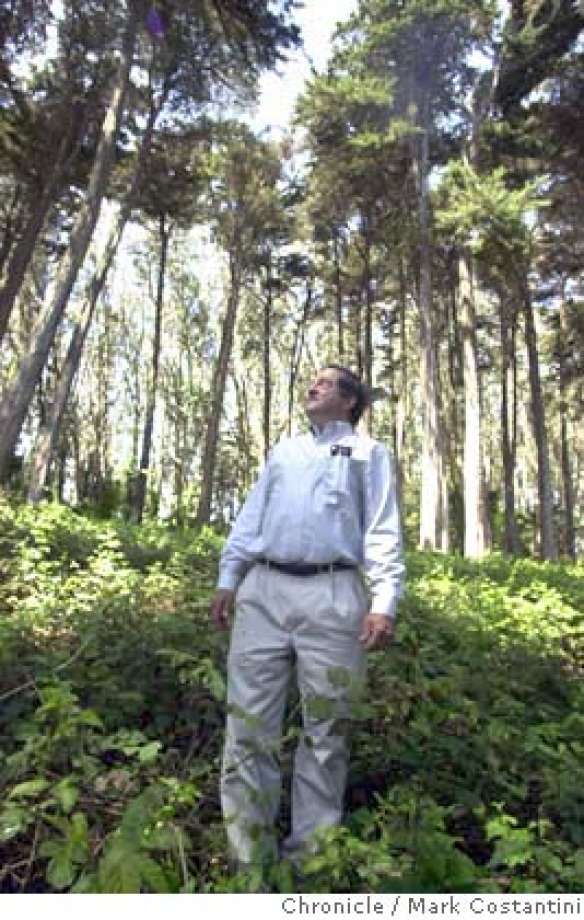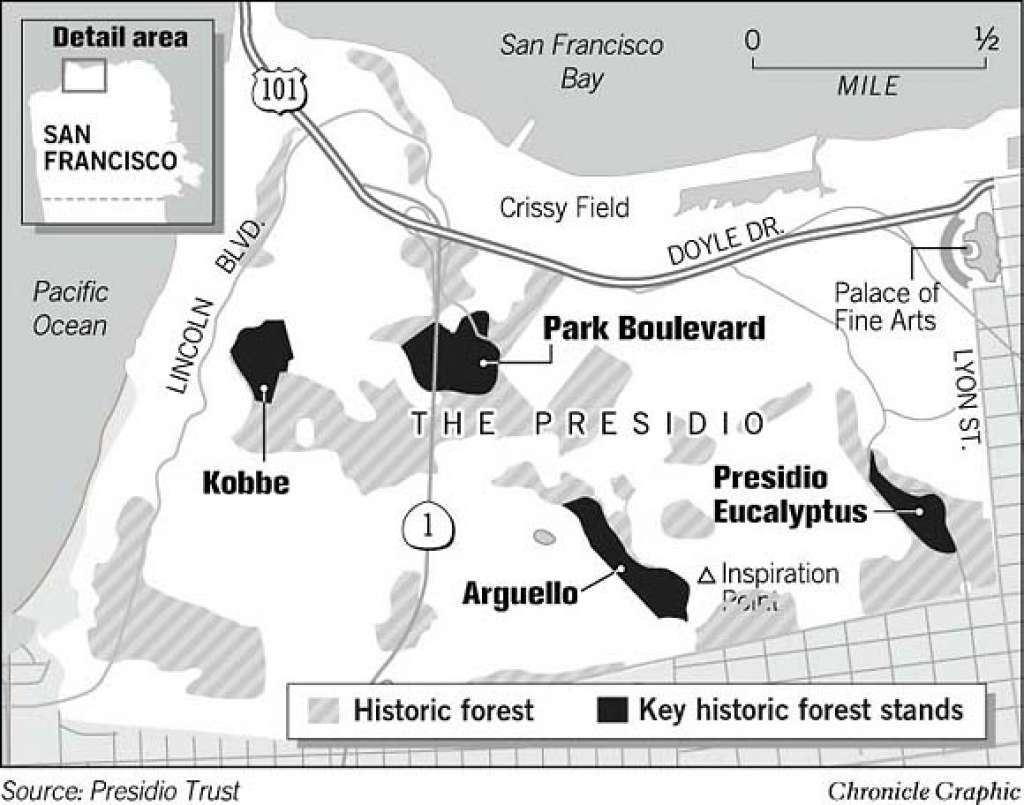
OVERVIEW
MANAGEMENT
PERFORMANCE
POSSIBILITIES
CAPITALS
ACTIVITIES
ACTORS
BURGESS
People ... Peter Ehrlich |
|
Burgess COMMENTARY |
|
SAN FRANCISCO / Crusade to save a dying forest / Presidio expert brings passion to towering task
The Presidio of San Francisco was not a popular posting for Army officers and enlisted men in the late 1800s, with its bracing winds coming off the Pacific blowing sand into the kitchens of military wives. That began to change after military officials in Washington, D.C., implemented an 1883 plan by Army Maj. W.A. Jones to plant 100,000 trees in the Presidio to serve as a windbreak, distinguish the post from the surrounding city and create a sense of majesty there. More than a century later, a forest considered so special it is included in the park's National Historic Landmark designation is slowly dying. And the federally chartered nonprofit trust that manages the Presidio has turned to Peter Ehrlich, 56, the former urban forester for the San Francisco parks department, to save it.
'If we waited another 50 years, there wouldn't be any trees left,' said Ehrlich, who joined the Presidio four years ago. Ehrlich faces the enormous challenge of preserving the 300-acre forest of the Presidio, where the trees march like soldiers across the former military base. In planning for the replanting of the forest over the next several decades, he must battle nature, negotiate with endangered species experts and navigate a federal bureaucracy with a small budget. Presidio officials say Ehrlich has just the mix of expertise, enthusiasm and negotiating skills to save the forest for future generations. 'When he came over to the Presidio I was thrilled,' said Amy Meyer, a former Presidio Trust board member. 'I knew he was knowledgeable and conscientious and he would do a good job. He cares about what he does. ... I've never seen him any other way.' Working with an $800,000 annual budget and five-man crew, Ehrlich cuts down aging trees and plants new saplings, covering an area of 2 to 4 acres per year. He estimates it will take 65 years to replace all the trees, converting a forest composed of trees of similar age into one in which only a few trees die and are replaced each year. At the center of the problem is how the forest was initially planted and how the Army failed to care for the trees over the past century. Starting in 1886, Army and civilian volunteers started planting trees at the Presidio, looking to the recent creation of Golden Gate Park as a shining example of an urban oasis for city dwellers. Most of the Presidio's trees were planted over the next 21 years, creating a uniformly aged forest that is now starting to die at the same time. Another problem is that the trees were planted too close together, forcing them to compete for light and water, and rendering them prone to disease. Maj. Jones wanted to thin out the young forest after it was planted in the 19th century -- cutting down some trees to give the rest enough room to grow -- but he was transferred out of the Presidio before he could implement his plan. Ehrlich's task would be easier if the trees, as planted incorrectly by the Army, weren't part of the Presidio's historic designation. Several 'historic stands' are included in the Presidio's National Historic Landmark District designation and must be preserved as close to the Army's design as possible. They include groups of trees near the Arguello Gate and the Presidio Gate entrances to the park, the Kobbe Avenue stand near the War Memorial and the Park Boulevard stand. Ehrlich must also take into account the park's work to restore native endangered plant and animal species and the activists who lobby the Presidio to protect them. The restoration of the forest, composed mostly of blue gum eucalyptus, Monterey pine, Monterey cypress, blackwood acacia and coast redwood, must be balanced with efforts to restore the native clarkia plant and the California quail, which are threatened with extinction. Ehrlich's task is further complicated by the fact that San Francisco is a city where residents don't always understand the need to cut down trees to preserve the forest for the future. City recreation and parks superintendent Dan McKenna, who supervised Ehrlich when he worked for the city, says the Presidio faces the same issues that confronted Golden Gate Park more than a century ago when park officials started to cull trees there. 'This was the first culling of the trees, where they overplanted an area and removed trees that were not performing well,' McKenna said. 'The public didn't understand. It's the same emotions Peter is dealing with now.' Ehrlich's fans say he can do it. A Bronx-born graduate of UC Berkeley's forestry school, he started his career at the city parks department clearing fallen trees in Golden Gate Park and worked as a reforestation gardener for 10 years. He eventually became the city's urban forester, overseeing most city parks, before he was recruited to the Presidio Trust in 2000. 'He's pretty clear about how important the forest is as a historic landmark,' said Craig Middleton, the trust's executive director. 'He also understands you have to take trees down to grow trees, to create enough light for young trees to come through. But what comes through most of all is his passion for the forest.' Ehrlich spends much of his time either looking up at the aging trees he cares for or looking down at recently planted saplings, digging in the dirt to feel if they're getting enough water. 'I'm obsessed with trees,' said Ehrlich, who lives in Petaluma with his wife and daughter. 'I grow trees in my backyard. I give trees away.' Ehrlich and his team have replaced about 5 acres of park forest so far. At Inspiration Point, 119 trees were removed to restore Jones' original vision of unobstructed views to the bay. After bird-nesting season ends in mid-August, workers will remove Monterey cypress trees in the West Pacific area in the southeast corner of the park and Monterey pine and Monterey cypress at Park Boulevard and Kobbe Avenue. Trees at four other sites by the Presidio golf course also will be removed. Replanting will start during the rainy season. Across the forest, the blue gum eucalyptus will eventually be replaced with less invasive species of eucalyptus. In an experiment, some Monterey pine trees will be replaced with trees cloned to prevent pine pitch canker, a disease that has ravaged trees around Central California. Ehrlich keeps Jones' plan in his office to remind him of the Army's original intent. The 13-page document includes maps where the trees would be planted, different species of trees and specific descriptions about how trees will be raised from seed. It also includes a stern reminder to anyone working to save the park: 'It should be remembered that we are in the midst of a great and growing city,' Jones wrote, 'that the eyes of people of culture are upon us, and that it is within our power to treat this matter so as to win delight and approbation on the one hand, or contempt and derision on the other.' Peter Ehrlich Presidio Trust forestry manager Birthplace: The Bronx Age: 56 Marital status: Married with one daughter. Favorite spot in the Presidio: Grove of about 120 redwood trees just below Inspiration Point. Favorite trees: Mountain hemlock, found in the coastal mountains from Central California to southern Alaska, and in the upper slopes of the Sierra; and the Brewer spruce, found in the Klamath Mountains. Favorite bird: Grey-horned owl (heard but not spotted this year at the Presidio). |
|
Katia Hetter, Chronicle Staff Writer
Published 4:00 am, Tuesday, July 6, 2004 |
| The text being discussed is available at http://www.sfgate.com/bayarea/article/SAN-FRANCISCO-Crusade-to-save-a-dying-forest-2743887.php and |

